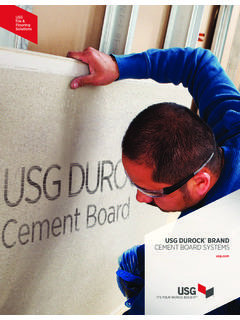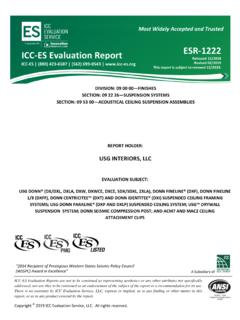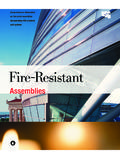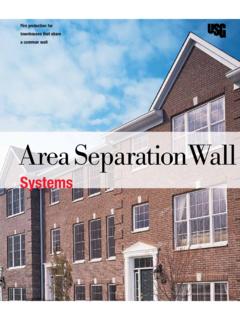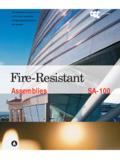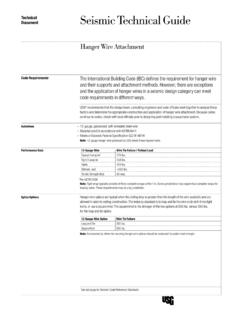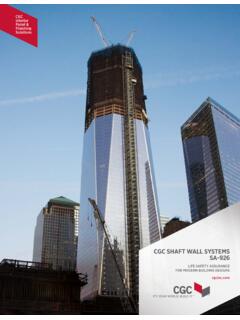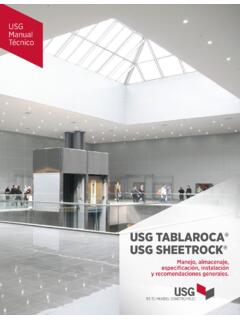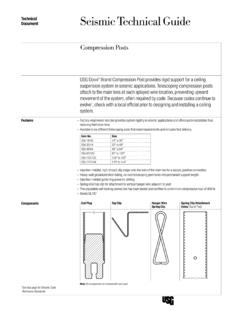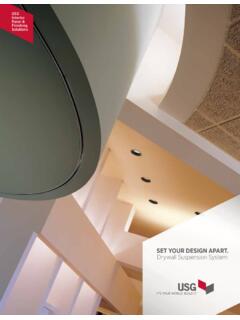Transcription of Technical Document Seismic Technical Guide - USG
1 Seismic Technical GuideTechnicalDocument Light Duty Suspension Systems astm C6351 addresses the load carrying capability of main tees, categorizing them as Light, Intermediate or Heavy Duty. This is also known as deflection Tee Load Carrying The associated load ratings are:Classifications Light Duty Intermediate Duty Heavy Duty 5 ( kg/m) 12 ( kg/m) 16 ( kg/m)Per astm C635, a suspension system main tee, when supported 48 in. and subjected to the respective load for its particular classification, cannot deflect more than L/360, where L equals the length of the unsupported span, or in this case, 48. For suspension system main tees, this deflection cannot exceed in.
2 If a main tee cannot carry the required load without exceeding its associated allowable deflection, it must, per astm C635, reduce its categorization appropriately ( from Intermediate to Light Duty). Deflection Example Note: 1/89 is noticeable to the human deflection criteria is measured for commercial construction because it is considered that 1/8 in. of deflection is typically noticeable to the human eye. Any deflection less than 1/8 in. would not be noticeable. The ultimate purpose of measuring main tees and assigning associated duty ratings per deflection criteria is for aesthetic purposes. This practice is commonly misunderstood as having a safety element; however the practice is purposely = 1/8 orL 36048 360 Length of span 360= 1 See last page for Seismic Code Reference Standards2 Light Duty Suspension Systems Partition BracingL/360 Deflection Criteria 16 lb.
3 Load is applied to main tee test specimen supported by a 4 ft. simple spanTest Method After load is applied any deflection is astm C635, a main tee is supported 4 ft. and subjected to the load for its duty classification; the tee may not deflect more than in. or L/360, where L equals the unsupported "6"6"1'1'1'Deflection Light Duty Suspension SystemsL48"6"6"1'1'1'weightsmain teeLight Duty Suspension Systemss 3 Special Applications Some applications present exceptional functional requirements or are subject to stringent criteria mandated by third parties such as USDA. USG offers several Donn systems that provide excellent design flexibility and meet the environmental demands found in some of the most challenging spaces such as: Special Applications Environmental Concerns Cleanrooms Contamination, humidity, pressure and airborne particles.
4 Indoor swimming pools Temperature and humidity. Non-magnetic environments Standard suspension systems can interfere with the performance of MRI and other equipment that uses or creates magnetic fields. Food service areas USDA Food Safety Inspection Service requirements. Restrooms and shower areas Temperature, humidity and wet cleaning. Parking garages and exterior soffits Temperature, humidity and wet cleaning. Laboratories Corrosive to the materials used to produce these specialized suspension systems, some are classified as Light Duty. USG understands that these specialized suspension systems may be necessary for their particular application. This can create a challenge in a Seismic application when a specialized suspension system is necessary to meet an exceptional functional requirement.
5 USG analyzed these requirements and prepared the following section to assist in these specialized Code Standards1 The International Building Code (IBC), through references to ASCE/SEI 7 Minimum Design Loads for Buildings and Other Structures, American Society of Civil Engineers/Structural Engineering Institute (ASCE/SEI) and astm International E 580/E 580M Standard Practice for Installation of Ceiling Suspension Systems for Acoustical Tile and Lay-in Panels in Areas Subject to Earthquake Ground Motions, defines the requirement for the main tee used in various Seismic design categories. The associated requirements are: Seismic Design Category A, BSeismic Design Category CSeismic Design Category D, E, FNo requirementIntermediate DutyHeavy DutyAlthough the duty rating system for main tees exists for aesthetic purposes, it has been an accepted part of Seismic ceiling standards for decades though the origin and logic for this remains unknown.
6 It has been proven that the connection strength of the suspension system is the critical factor needed to endure the lateral forces exerted on the suspension system in a Seismic event, and Donn suspension systems have set the standard, using the strongest gauge steel to produce the tightest systems available with the greatest lateral and torsional stiffness. As a result, USG teamed with the University at Buffalo (SUNY), the Department of Civil, Structural and Environmental Engineering Structural Engineering and Earthquake Simulation Laboratory (SEESL) and the Pacific Earthquake Engineering Research Center (PEER) University of California, Berkeley to conduct full-scale Seismic testing to evaluate and qualify the Seismic performance of our systems.
7 Light Duty Suspension Systems 1 See last page for Seismic Code Reference Standards4 Light Duty Suspension Systems Light Duty Systems USG offers the following products. AX AX , an aluminum suspension system for high-humidity or wet-cleaned areas such as food-processing areas. The aluminum components can also be used in non-magnetic environments such as magnetic-free zones and MRI rooms. DXSS USG also offers DXSS , a stainless steel system for non-magnetic requirements and resistant to direct and indirect contact with many corrosive agents, making it an ideal material for use in industrial and laboratory applications. Both systems meet USDA/FSIS requirements.
8 Both the AX and DXSS suspension systems have main tees that are classified as Light Duty per astm C635. Note: USG recommends that the design team, consulting engineers and code officials work together to analyze these factors and determine the appropriate construction and application. Because codes continue to evolve, check with local officials prior to designing and installing a suspension Wire Spacing Reducing the hanger wire spacing on the main tees from 4 ft. to 30 in. for AX and 4 ft. to 3 ft. for DXSS can achieve Heavy Duty load carrying capacity values to satisfy this requirement. AX Construction DXSS Construction30 ceilingstructuremain tee Light Duty Suspension Systems3 ceilingstructuremain teeLight Duty Suspension Systemss 5 Main TeeAXDXSSH anger Support Spacing309 Allowable Load ( ) at L/360 Deflection19 lbs23 lbsEquivalent Duty Rating1 HeavyHeavySuspension System Seismic Requirements2 Heavy Duty Main Tee Classification3 Satisfies RequirementSatisfies Requirement Minimum main tee and cross tee intersection strength limits = 180 Requirement:Cross Tee = 207 lbs Main Tee = 205 lbsExceeds Requirement.
9 Cross Tee = 462 lbsMain Tee = 536 lbs Connection device from vertical wire to the structure above must sustain min. 100 Requirement:205 lbsExceeds Requirement:+500 lbs1 Reducing the hanger wire spacing on main tees can achieve heavy duty load carrying capacity values to satisfy this requirement, but does not change the duty classification of the main There are various product and installation Seismic requirements for suspended ceilings. Listed are the suspension system require-ments only. For a complete listing of the Seismic requirements for suspended ceilings please visit or refer to The International Building Code (IBC), ASCE/SEI7 Minimum Design Loads for Buildings and Other Structures, American Society of Civil Engineers/Structural Engineering Institute (ASCE/SEI) and astm International E 580/E 580M Standard Practice for Installation of Ceiling Suspension Systems for Acoustical Tile and Lay-in Panels in Areas Subject to Earthquake Ground Heavy Duty is required for IBC Seismic Design Category D-F and Intermediate Duty is required for IBC Seismic Design Category.
10 The performance of Donn suspension systems is based on the specific combination of superior components, and the design and installation methods shown. Components from other manufacturers were not evaluated, and their use or any mixed use is not recommended. Many jurisdictions accept the installation of Light Duty main tees with additional supports, however, some jurisdictions will not accept this application. Check with a local official prior to designing and installing a Light Duty ceiling system. Light Duty Suspension SystemsCode Approval USG believes these alternative designs are at least the equivalent of that prescribed in the code for quality, strength, effectiveness, durability and safety.
